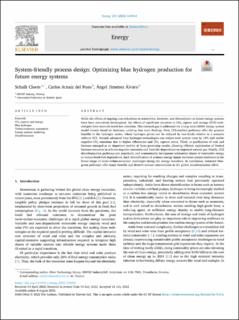| dc.contributor.author | Cloete, Schalk Willem Petrus | |
| dc.contributor.author | Arnaiz del Pozo, Carlos | |
| dc.contributor.author | Jiménez Álvaro, Ángel | |
| dc.date.accessioned | 2022-11-18T08:08:05Z | |
| dc.date.available | 2022-11-18T08:08:05Z | |
| dc.date.created | 2022-11-02T14:44:42Z | |
| dc.date.issued | 2022 | |
| dc.identifier.citation | Energy. 2022, 259 1-14. | en_US |
| dc.identifier.issn | 0360-5442 | |
| dc.identifier.uri | https://hdl.handle.net/11250/3032713 | |
| dc.description.abstract | While the effects of ongoing cost reductions in renewables, batteries, and electrolyzers on future energy systems have been extensively investigated, the effects of significant advances in CO2 capture and storage (CCS) technologies have received much less attention. This research gap is addressed via a long-term (2050) energy system model loosely based on Germany, yielding four main findings. First, CCS-enabled pathways offer the greatest benefits in the hydrogen sector, where hydrogen prices can be reduced by two-thirds relative to a scenario without CCS. Second, advanced blue hydrogen technologies can reduce total system costs by 12% and enable negative CO2 emissions due to higher efficiencies and CO2 capture ratios. Third, co-gasification of coal and biomass emerged as an important enabler of these promising results, allowing efficient exploitation of limited biomass resources to achieve negative emissions and limit the dependence on imported natural gas. Finally, CCS decarbonization pathways can practically and economically incorporate substantial shares of renewable energy to reduce fossil fuel dependence. Such diversification of primary energy inputs increases system resilience to the broad range of socio-techno-economic challenges facing the energy transition. In conclusion, balanced blue-green pathways offer many benefits and deserve serious consideration in the global decarbonization effort. | en_US |
| dc.language.iso | eng | en_US |
| dc.publisher | Elsevier | en_US |
| dc.rights | Navngivelse 4.0 Internasjonal | * |
| dc.rights.uri | http://creativecommons.org/licenses/by/4.0/deed.no | * |
| dc.subject | Decarbonization | en_US |
| dc.subject | Energy systems modelling | en_US |
| dc.subject | Techno-economic assessment | en_US |
| dc.subject | Blue hydrogen | en_US |
| dc.subject | CO2 capture and storage | en_US |
| dc.title | System-friendly process design: Optimizing blue hydrogen production for future energy systems | en_US |
| dc.title.alternative | System-friendly process design: Optimizing blue hydrogen production for future energy systems | en_US |
| dc.type | Peer reviewed | en_US |
| dc.type | Journal article | en_US |
| dc.description.version | publishedVersion | en_US |
| dc.rights.holder | © 2022 The Authors. Published by Elsevier Ltd. | en_US |
| dc.source.pagenumber | 1-14 | en_US |
| dc.source.volume | 259 | en_US |
| dc.source.journal | Energy | en_US |
| dc.identifier.doi | 10.1016/j.energy.2022.124954 | |
| dc.identifier.cristin | 2068167 | |
| dc.source.articlenumber | 124954 | en_US |
| cristin.ispublished | true | |
| cristin.fulltext | original | |
| cristin.qualitycode | 2 | |

